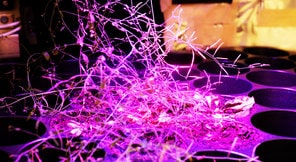A Laser-Based Illumination Technology for Indoor Horticulture Applications
Laser-based technology to significantly enhance the dynamics and economics of the agri-food industry
Technology Summary
Horticulture activities rely heavily on two important resources: light and water.
Artificial lighting technologies are particularly useful in countries with limited sunlight and rainfall. In arid regions such as Saudi Arabia and the Middle East, over 95 percent of water can be lost through evaporation.
Due to the scarcity of water in these regions, it is often necessary to cultivate plants in an enclosed environment, which can conserve water by up to 90 percent.
Prof. Boon and his team at KAUST have developed a laserbased illumination system for indoor plant cultivation that is both efficient and cost effective.
The laser-based system replaces traditional fluorescent or LED technologies that are energy intensive and require constant monitoring for maintenance purposes. A single source of laser can potentially replace hundreds of fluorescent light tubes and LED lights.
How it works
The technology uses a laser-module that can be strategically directed at several rows of plants or crops in horticultural applications.
The technology is scalable and validated in model plants (arabidopsis thaliana) that have shown positive growth compared to growth under white fluorescent light.
The laser is high powered and can be tuned to produce the required intensity of light based on specific crops and plants. The laser panels and optics are based outside the horticulture chamber and are guided through access ports to the growth chambers in a single-tier or multi-tier plant cultivation setup.
Why it is better
This new technology can last up to 20,000 hours compared to traditional fluorescent technologies that need to be replaced every 4,400 hours or so.
It delivers more light to larger areas at a higher power. It also does not suffer from degrading efficiency (known as efficiency droop in LED technologies).
As light can be remotely generated and delivered, the scalable technology saves maintenance costs compared to existing technologies.
The technology is energy efficient, does not require cooling and saves both water and space. In addition, it can also turn off and on in a fraction of a second to generate the exact amount of light required for effective and efficient photosynthesis.
IP protection
KAUST has several patents pending on this technology.
Invention Track Code
2014-064

Benefits
- Reduced energy and water consumption
- Plant-specific growth optimization
- Saves space
- Single source of light

Applications
- Indoor plant and crop cultivation
- Vertical horticulture
- Chemical-free organic farming

